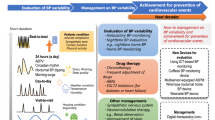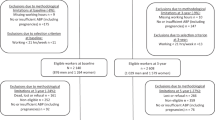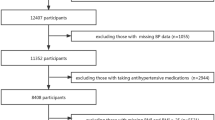Abstract
Shift workers make great use of health care services because they are associated with increased cardiovascular morbidity and mortality. Whether the circadian rhythm of blood pressure rapidly adapts to shift work is controversial. It is unknown if shift work has adverse effects on blood pressure in patients with hypertension. To evaluate the effects of shift work, we examined 12 male shift workers with untreated hypertension aged 53.6 ± 2.5 years. Twenty-four hour ambulatory blood pressure monitoring was performed three times as follows: the last day of a 4-day period of day shifts (09.00 to 21.00), the first day of a 4-day period of night shifts (21.00 to 09.00), and the fourth day of night shifts (21.00 to 09.00). Blood pressure at night-time dropped significantly in the day-shift workers, showing a dipper pattern. Average differences in blood pressure in the sleep-wake cycle were decreased by 8.5% at the beginning of night shift work showing a non-dipper pattern. After 4 days the pattern was completely reversed to a dipper pattern. The results indicate that the circadian blood pressure pattern is changed from a dipper to a non-dipper pattern on the first day of the night shift and reverses to a dipper pattern within a few days. We suggest that night shift work may have unfavourable effects on blood pressure in patients with hypertension.
This is a preview of subscription content, access via your institution
Access options
Subscribe to this journal
Receive 12 digital issues and online access to articles
$119.00 per year
only $9.92 per issue
Buy this article
- Purchase on Springer Link
- Instant access to full article PDF
Prices may be subject to local taxes which are calculated during checkout



Similar content being viewed by others
References
Nagai K et al. Circadian rhythms and energy metabolism and special reference to the suprachiasmatic nucleus Neurosci Biobehav Rev 1994 18: 579–584
Sundberg S, Kohvakka A, Gordin A . Rapid reversal of circadian blood pressure rhythm In shift workers J Hypertens 1988 6: 393–396
Baumgart P et al. Twenty-four-hour blood pressure is not dependent on endogenous circadian rhythm J Hypertens 1989 7: 331–334
Chau NP et al. Twenty-four-hour ambulatory blood pressure in shift workers Circulation 1989 80: 341–347
Mann S, Altman D, Raftery E, Bannister R . Circadian variation of blood pressure in autonomic failure Circulation 1983 68: 477–483
Kario K, Shimada K . Change In diurnal blood pressure rhythm due to small lacunar Infarct Lancet 1994 344: 200 (Letter)
O'Brien E, Sheridan J, O'Malley K . Dippers and non-dippers. (Letter) Lancet 1988 2: 387
Shimada K et al. Diurnal blood pressure variations and silent cerebrovascular damage In elderlypatients with hypertension J Hypertens 1992 10: 875–878
Verdecchia P et al. Ambulatory blood pressure. An independent predictor of prognosis in essential hypertension Hypertension 1994 24: 793–801
Yamasaki F et al. Impact of shift work and race/ethnicity on the diurnal rhythm of blood pressure and catecholamines Hypertension 1998 32: 417–423
Kuwajima I, Nishinaga M, Kanamaru A . The accuracy and clinical performance of a new compact ambulatory blood pressure monitoring device, the ES-H531 Am J Hypertens 1998 11: 1328–1333
Armitage P, Berry G (eds). Statistical Methods in Medical Research (2nd edn) Blackwell Scientific: Oxford, UK 1987
Lusardi P et al. Effect of insufficient sleep on blood pressure in hypertensivepatients Am J Hypertens 1999 12: 63–68
Motohashi Y et al. Alteration of circadian time structure of blood pressure caused by night shift schedule Occup Med (Lond) 1998 48: 523–528
Campbell SS . Effects of timed bright-light exposure on shift-work adaptation in middle-aged subjects Sleep 1995 18: 408–416
Hakola T, Harma MI, Laitinen JT . Circadian adjustment of men and women to night work Scand J Work Environ Health 1996 22: 133–138
Akerstedt T . Sleepiness as a consequence of shift work Sleep 1988 11: 17–34
Knutsson A, Akerstedt T, Jonsson BG, Orth-Gomer K . Increased risk of ischaemic heart disease in shift workers Lancet 1986 2: 89–92
Kawachi I et al. Prospective study of shift work and risk of coronary heart disease in women Circulation 1995 92: 3178–3182
Moore-Ede MC, Richardson GS . Medical implications of shift-work Annu Rev Med 1985 36: 607–617
Furlan R et al. Modulations of cardiac autonomic profile associated with a shift schedule of work Circulation 2000 102: 1912–1916
Ziegler JL et al. Stress and medical training – Medical Staff Conference, University of California, San Francisco West J Med 1985 142: 814–819
Yetman RJ, West MS, Portman RJ . Changes in circadin rhythm of blood pressure in on-call pediatric residents Chronobiol Int 1994 11: 54–61
Narkiewicz K et al. Interactive effect of cigarettes and coffee on daytime systolic blood pressure inpatients with mild essential hypertension J Hypertens 1995 13: 965–970
Author information
Authors and Affiliations
Corresponding author
Rights and permissions
About this article
Cite this article
Kitamura, T., Onishi, K., Dohi, K. et al. Circadian rhythm of blood pressure is transformed from a dipper to a non-dipper pattern in shift workers with hypertension. J Hum Hypertens 16, 193–197 (2002). https://doi.org/10.1038/sj.jhh.1001328
Received:
Revised:
Accepted:
Published:
Issue Date:
DOI: https://doi.org/10.1038/sj.jhh.1001328
Keywords
This article is cited by
-
Lifestyle interventions for the prevention and treatment of hypertension
Nature Reviews Cardiology (2021)
-
The relation of work-related factors with ambulatory blood pressure and nocturnal blood pressure dipping among aging workers
International Archives of Occupational and Environmental Health (2020)
-
Clinical significance of stress-related increase in blood pressure: current evidence in office and out-of-office settings
Hypertension Research (2018)
-
Blood pressure regulation VII. The “morning surge” in blood pressure: measurement issues and clinical significance
European Journal of Applied Physiology (2014)
-
Chronotherapy improves blood pressure control and reduces vascular risk in CKD
Nature Reviews Nephrology (2013)



